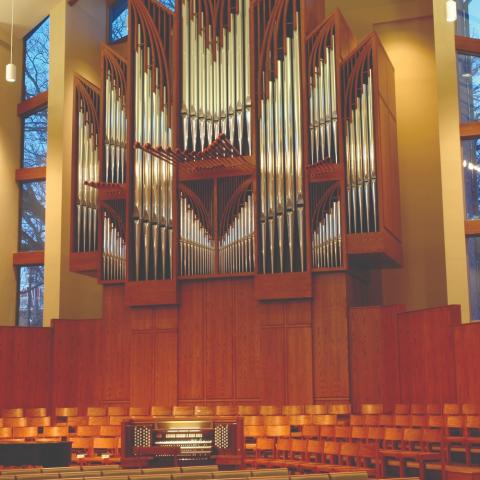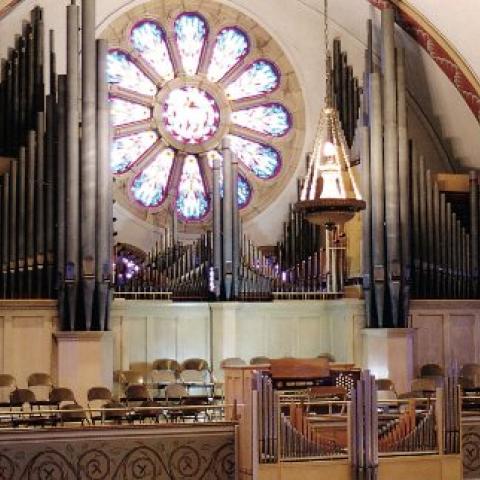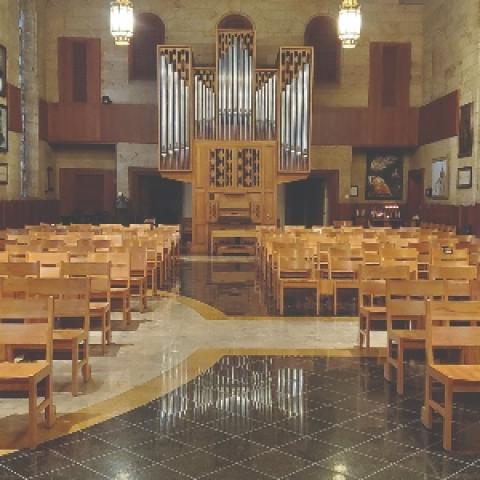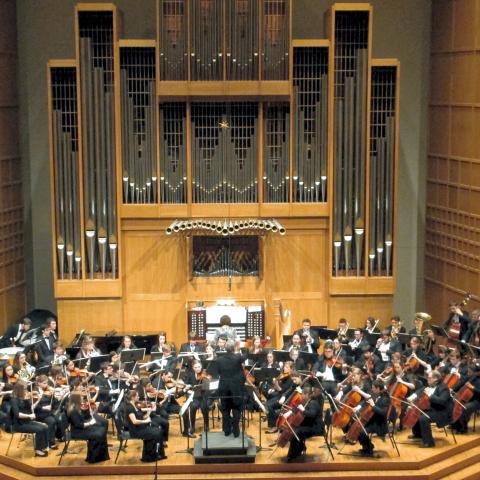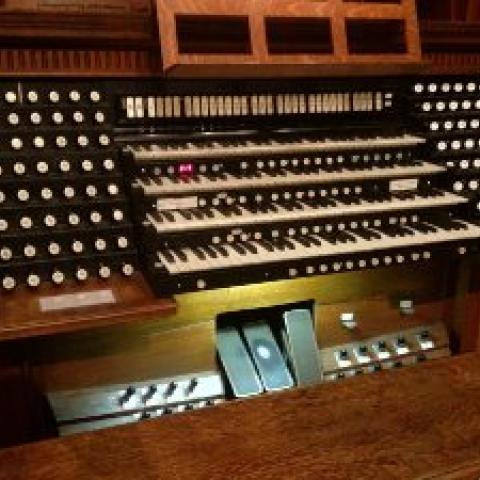Craig R. Whitney, an organist since he was a teenager, worked as a reporter, foreign correspondent, and editor at The New York Times over forty-four years, retiring in 2009. Among his books is All the Stops: The Glorious Pipe Organ and Its American Masters (PublicAffairs, 2003).

The twenty-two-rank electro-pneumatic-action pipe organ designed and built by the Aeolian-Skinner Organ Co. of Boston, Massachusetts, for the Metropolitan Opera House in New York City and installed there in 1966 was taken out for a long-needed thorough rejuvenation over the summer by the Schantz Organ Company of Orrville, Ohio. The unique instrument with two manuals and 1,289 pipes in twelve voices and twenty-two ranks was whisked away from Lincoln Center to Ohio last April after undergirding that season’s final performance of Tosca. It was trucked back to New York and reinstalled backstage in the vast opera house at the end of August in a new steel-framed, wheeled enclosure, in time to give powerful support to orchestra and chorus in Tosca again starting October 4, in Peter Grimes a few days later, and Lohengrin in February.
The organ, Aeolian-Skinner’s Opus 1444, was the work of Joseph S. Whiteford when he was company chairman and tonal designer. Schantz made no tonal changes to the instrument, its vice president, Jeffrey Dexter, affirmed. “This was literally a restoration,” he told me. One of the Opera’s organists, Dan Saunders, summed up what had to be done this way, “We played it to death—it needed to be brought back to life.”
Thomas Lausmann, who became the Opera’s director of music administration at the start of the 2019–2020 season, soon heard about the organ’s problems from Douglass Hunt, who looks after organs all around New York City and has been the Metropolitan Opera’s organ technician for thirty-six years. “Doug was afraid that the two main reservoirs might fail,” Lausmann said. “I began to see that the organ was holding on, but for how long, we couldn’t know.” Yannick Nézet-Séguin, the Philadelphia Orchestra’s director who had taken on the additional position of music director at the Metropolitan Opera in 2018, heard about the problems and turned to a friend for advice. This was Frederick Haas, himself an organist and a director of his family’s Wyncote Foundation in Philadelphia who has steered major donations to the Philadelphia Orchestra and many other institutions. Historic organ preservation projects are high on the list. “I was always intrigued that the Metropolitan Opera had an organ, and I went up and played it,” Haas told me. “It is original—a weird specification, but then, the organ in an opera is supposed to be under and over the orchestra, not through it.” He agreed that if it needed a complete restoration, he would see to the cost. Wyncote has—all $500,000 of it.
In a sense, Whiteford’s design for the instrument was something of an experiment in the mid-1960s. Aeolian-Skinner and Whiteford had built a four-manual concert hall organ for Philharmonic Hall, next door to the Opera, in 1962, but the opera house did not need a huge instrument; it needed one that could reinforce and undergird full orchestra and chorus in some scenes, and delicately support soloists in others. Writing in The Diapason in 1965, he allowed that the company had produced “a two-manual plan which looks very strange on paper and it is probably the only one around with a 32 ft. reed.” Aeolian-Skinner came up with that plan after doing “a great deal of research” into how many operas called for an organ or harmonium, “a surprising number,” Whiteford admitted. “The organ for opera, in a sense, is like scenery—it is not a complete organ,” he wrote. This one, in his words, is “essentially a Bombarde Organ superimposed on a small but varied group of flue voices.”1
The whole organ was housed in a single enclosure with swell shades on its front side, all on wheels so it could be moved around. But moving such a bulky and heavy instrument posed challenges, and it was instead planted permanently backstage, stage left (the right side, as seen from the audience) for most of fifty-six years, unseen—but heard, thanks to the ingenuity of the Opera’s technical staff and organists in coping with its peculiarities.
One of the first on the bench was the late John Francis Grady, who went on in 1970 to become organist and music director at Saint Patrick’s Cathedral in New York City. He was asked then what it was like to play in the opera house. “You might say I play on 63rd Street and the pipes are on 65th,” he told The New York Times. “They’re about a block and a half away, and I must be a quarter of a beat ahead of the conductor at all times.” With most orchestras usually just a shade behind the conductor, he said, “It comes out right when I’m early, they’re late, and he’s in the middle.”2
One of his successors playing organ at the Opera now, Bradley Moore, told me that it was difficult to see the conductor from the console, deep in a far corner of the orchestra pit, under the lip of the stage. “And you couldn’t hear yourself very well down there,” he said. “In Die Meistersinger von Nürnberg once I started playing at the end of the ‘Prelude,’ and when the orchestra subsided and I could hear the organ I realized that I was a whole measure ahead of them.”
So the technical staff devised a visual monitor aimed at the podium that allows the organist to see the conductor on a little screen above the keyboards. They also put a microphone near the organ pipes 150 feet away to allow the organist to hear the instrument more clearly through an audio monitor at the console when it was playing with the orchestra or while accompanying singers.
Still, Howard Watkins, who has been with the Opera for twenty-four years and often plays organ parts, said “the old beast” had become more and more cantankerous over the years—sometimes unexpectedly going silent and sometimes not turning on at all. “Once, in Tosca, it started working but then cut out—the tech staff worked on it almost all through the first act before they could get it going again for me.”
So with the finances for a renovation assured, the Opera decided to go ahead last spring, and Schantz got the job and took the organ away. Lausmann had been through a similar restoration of an opera-organ in his previous post at the State Opera in Vienna. He, Jeff Mace, director of productions operations, and Doug Hunt as project consultant and organ expert all agreed that only one minor change in the pipework ought to be made—replacement of the unusually-shaped shallots in the bottom twenty-four pipes of the 16′ Bombarde register and its extension in the Pedal as a 32′ Contre Bombarde. Whiteford had installed these shallots as an experiment, with a curved shape that had long made the thundering lower notes hard to tune—“fidgety,” as Hunt put it.
Once in Ohio, Schantz built a new and stronger enclosure. Most of the summer, the factory workers were busily cleaning pipes, releathering reservoirs and pneumatics, renewing worn electro-pneumatic components, and they replaced those twenty-four curved-face shallots with straight ones. A small team from the company, led by Rob Baumgartner, then brought it all back from Ohio to New York on a flatbed truck in late August and unloaded it backstage at the Opera. Everything looked good as new as they spent a week putting the organ back together. Smaller pipes were laid out in neat rows on the floor as the workers were putting them into place on the chests, while the big closed 16′ pedal bass pipes stood guard at the other end of the cage—all while dozens of workers from the Opera’s team scuttled around pushing and pulling sets and fixings to get ready for the September season opening.
Baumgartner said Schantz would have brought a bigger crew, but some of the company’s workers lacked covid vaccination certificates, and the Opera has required those of everybody who comes in. But the opera stage crews pitched right in whenever help was needed, as when they lifted an 800-pound chest into place inside the chamber that Baumgartner said would otherwise have required him to build a hoist mechanism. “These are great workers here,” he beamed.
The new enclosure is really a big swell box, a chamber that encloses the whole organ, seventeen feet wide, seventeen feet high, and nine feet deep. It has wheels, steel ones, but since the whole instrument weighs about nine tons, it probably isn’t going to move around any more than it did over its previous lifetime. Its back and side walls of KorPine one-inch thick are overlaid with sheet metal, all flat black. In front, the expression louvers—the original ones, restored—have protective steel bars outside them to ensure no danger of accidental damage from all the surrounding backstage activity. The organ case’s roof is reinforced like its walls to ward off falling objects, and its front is canted upward to 17′ 10¾′′ to better project the organ’s sound. The audience hears the organ after its sound has passed to the main stage and then out into the vast opera house, which can hold up to 4,000 people.
And the organist can only hear it then, too! The console, with two sixty-one-note keyboards, stop and expression controls, and thirty-two-note pedalboard, is almost buried in the orchestra pit, where it always was before, deep down under the lip of the stage on the far-left side as seen from the audience (stage right). The player is facing but cannot see the conductor unobstructed, because of the intervening double-bass stringed instruments and players. Schantz renewed and updated the console mechanism controls with a new solid-state system to transmit commands from organists’ fingers and feet and signals from combination pistons and couplers to the pipes, all designed to be trouble-free, a Multisystem II by Solid State Organ Systems. And all of the new electrical needs of the instrument and connections between the console and the organ were designed and fabricated by the Met’s own electrical department and metal shop personnel.
“Our hope is that we gain a lot more security and better sound,” Howard Watkins said. That is, no more failures, and clearer tone.
Tuning and final voicing touches were being done in September by another team from Schantz led by Jeffrey Dexter, its tonal director. The temperature must be cooled down to 70 degrees Fahrenheit to get the required A–440 Hz pitch, but the Metropolitan Opera can do that even in a heat wave.
And then it was off to the 2022–2023 season. “There’s nothing more thrilling than playing in the ‘Te Deum’ at the end of the first act of Tosca,” enthused Dan Saunders, who was the first to do it again on the restored organ on October 4, hoping to evoke what his colleague Howard Watkins calls “its own magisterial color” and move the audience with the thrilling power of its deep bass and bombarde pedal pipes. And all who were there that night were deeply moved as the full chorus, orchestra, and organ all roared out Puccini’s thrilling setting of “Te aeternum Patrem omnis terra veneratur.”
Another renewal, next to the Opera House, followed a week later, the reopening of the home of the New York Philharmonic Orchestra, which had an Aeolian-Skinner concert organ when it opened as Philharmonic Hall in 1962 but removed it in 1976 when the hall, renamed earlier for Avery Fisher, was acoustically redesigned. Now, after another renaming as David Geffen Hall, it has been redesigned again. Fred Haas would have been willing to help contribute to get a pipe organ, but, he said, “The powers that be just didn’t want it.” Instead, they settled for a large, pipeless, electronic organ.
Notes
1. Joseph S. Whiteford, “Two Manual Organs,” The Diapason, September 1965: 35.
2. McCandlish Phillips, “St. Patrick’s Names Met Organist as Music Director,” The New York Times, August 31, 1970.
1966 Aeolian-Skinner Organ Co. Opus 1444
MANUAL I (enclosed)
8′ Prinzipal 61 pipes
8′ Bourdon 61 pipes
4′ Oktave 61 pipes
2′ Super Oktave 61 pipes
Mixtur IV–VI 277 pipes
Man I 16
Man I 4
II to I 16
II to I 8
II to I 4
MANUAL II (enclosed)
8′ Gemshorn 61 pipes
8′ Rohrflöte 61 pipes
4′ Flûte Harmonique 61 pipes
2′ Blockflöte 61 pipes
Ripieno VI 366 pipes
16′ Bombarde 61 pipes
8′ Trompette 61 pipes
Man II 16
Man II 4
PEDAL
16′ Subbass (a) 12 pipes (ext Man. I 8′ Bourdon)
16′ Sanftbass 12 pipes (ext Man. II 8′ Rohrflöte)
8′ Prinzipal (Gt 8′)
8′ Gemshorn (Sw 8′)
4′ Prinzipal (Gt 8′)
32′ Contre Bombarde (b) 12 pipes (ext Sw 16′)
16′ Bombarde (Sw 16′)
8′ Bombarde (Sw 16′)
I to Pedal 8
I to Pedal 4
II to Pedal 8
II to Pedal 4
Accessories
6 Ensemble (General) pistons
General Cancel
Balanced expression shoe (with bar graph indicator)
Balanced Crescendo shoe (with bar graph indicator)
Wind indicator
5-3⁄8′′ wind pressure
22 ranks, 20 stops, 12 voices, 1,289 pipes
(a) Pipes in stock, possibly from Opus 408, Trinity Church, New York City, unverified.
(b) Possibly Opus 1433 chest and pipes from First Unitarian Church, Worcester, Massachusetts, unverified.

